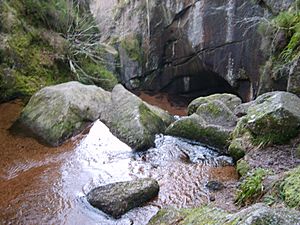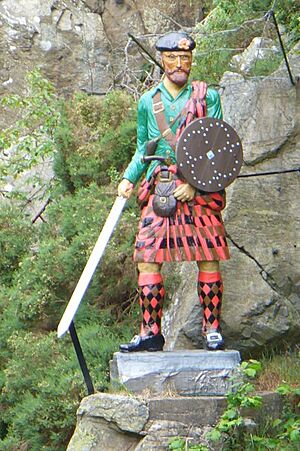Gilderoy (outlaw) facts for kids
Quick facts for kids
Patrick McGregor
|
|
|---|---|

An illustration of McGregor
|
|
| Born | |
| Died | 1636 Edinburgh, Scotland
|
Patrick McGregor (Scottish Gaelic: Pàdraig MacGriogair) was a Scottish outlaw who lived a long time ago, during the Stuart period. He was better known by his nickname, Gilderoy. After being caught by the authorities in Scotland, he was put to death in Edinburgh in 1636. Even though he was an outlaw, Gilderoy became a famous character in Scottish folklore. People told stories about him in ballads and songs. His nickname is sometimes spelled as Gilroy, Gilder Roy, or Gilleroy.
Contents
Who Was Gilderoy?
Patrick McGregor, or Gilderoy, was the leader of a group of robbers. He was known for stealing cattle and demanding money for protection. His nickname, Gilderoy, comes from the Scottish Gaelic words Gille Ruadh, which mean 'the Red-haired Lad'. This was because he had bright red hair, which was common in Scotland. People also sometimes called him the 'Bonnie Lad'.
Gilderoy is often compared to other famous outlaws like Robin Hood from England. He is also sometimes confused with Rob Roy MacGregor, another Scottish outlaw who lived much later (from 1671 to 1734).
Gilderoy's Hiding Place
There's a cool rock formation called the Burn O'Vat near Ballater in Scotland. Many people think this was a hiding place for Rob Roy MacGregor. But it's actually quite far from where Rob Roy usually lived. Old stories say that Gilderoy used this spot instead. He might have even been related to Rob Roy.
There's a small dip behind the main waterfall at Burn o'Vat. It's known as "Gilderoy's Cave." It's said that he once hid there from people chasing him. He would hide behind the waterfall when the stream was full of water. In 1636, some people, like Sir James Grant and Sir Alexander Irvine, got into trouble for letting Gilderoy hide on their land.
Gilderoy was put to death in 1636. However, many stories about his life were written later. These stories often changed the facts, making them much more exciting and romantic. Some even said he died as late as 1658.
Popular Stories About Gilderoy
Many popular books told tales about Gilderoy's life. One example is Lives and Exploits of English Highwayman, Pirates and Robbers. These books often changed the time period of his adventures. They also added many wild and made-up parts. In these stories, Gilderoy was seen as a hero, much like Robin Hood or Twm Siôn Cati.
One story claims Gilderoy came from a rich family in Perthshire. He supposedly inherited his family's estate when he was 21. But he quickly spent all the money and lost the estate. The story says his mother then refused to give him more money. Because of this, he supposedly set fire to her house after stealing her valuables.
A large reward was offered for his capture in these tales. Gilderoy was said to have run away to France. There, he bought fancy clothes. One day, he was in a church near Paris where a famous leader, Cardinal Richelieu, was speaking. The king was also there. Gilderoy supposedly stole money from the cardinal's purse. The king saw him, but Gilderoy made a sign as if it was a joke. Later, the king realized he had been tricked!
After three years away, Gilderoy supposedly felt it was safe to return to Scotland. In these made-up versions, he took advantage of the confusion during the English Civil War (1642–1651). He gathered a group of robbers and caused trouble in many areas. He would demand cattle from people to "protect" them. This was a practice known as blackmail. One story says he stole a diamond ring, a gold watch, and 80 gold coins from the Earl of Linlithgow.
Another story even brings in Oliver Cromwell, a famous English leader. Gilderoy supposedly found out Cromwell was traveling through Scotland. He decided to rob him. Even though Cromwell only had two helpers, he chose to fight. Gilderoy supposedly shot one of Cromwell's helpers and injured the other. He also shot Cromwell's horse, causing Cromwell to break his leg. Gilderoy then let Cromwell live, put him on a donkey, and sent him on his way.
In these stories, three of Gilderoy's men were later caught and hanged. A reward of 1000 marks was offered for Gilderoy, dead or alive. His girlfriend, Margaret Cunningham, supposedly decided to betray him. She arranged for 40 soldiers to capture him at her home.
The stories say Gilderoy was chained up tightly. After three days in the Edinburgh Tollbooth prison, he was hanged from a very tall gallows in April 1658. He was supposedly 34 years old when he died and showed no sadness.
Gilderoy in Poems and Songs
Even though Gilderoy's real life was tough, he became a romantic figure in poems and songs. Here is the first part of a poem from 1783, showing how he was remembered:
|
An old copy from around 1650 shows that this song was popular in England. It also appeared in a music book called "Wit and Mirth" in 1702. A man named John Niven wrote down the tune "The Flowers of Scotland - Gilderoy" in the 1760s.
The tune Gilderoy also appeared in other old music collections. These include Pills to Purge Melancholy from 1707 and Tea Table Miscellany from around 1726. It was also in Orpheus Caledonius from 1733.
The Wordsworth Dictionary of Phrase and Fable from 1870 mentions a saying: "To be hung higher than Gilderoy's kite". This means to get a punishment that is much worse than what even the worst criminals usually get!
|
A more recent poem about "Gilderoy" was written by Thomas Campbell (1777–1844). It's called "Roslin Gilderoy". However, this poem is probably about a different person with the same nickname. That person was also hanged in Edinburgh for stealing animals in the 1700s. Here is the first part of that poem:
|
Gilderoy's Legacy
The famous Scottish poet Robert Burns used a version of the Gilderoy melody for his song From Thee Eliza.
Ann Gilrye was the mother of John Muir, a famous person who helped protect nature. He was born in Scotland. Because of her last name, his family adopted 'Gilderoy' as their special song. You can see this at the John Muir Museum in Dunbar.
You might also know a character named Professor Gilderoy Lockhart from the Harry Potter books and movies. He is a famous author and a teacher at Hogwarts in Harry Potter and the Chamber of Secrets.
See also



